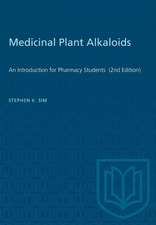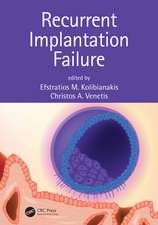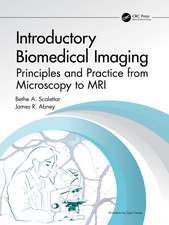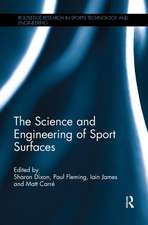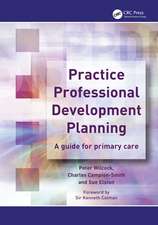Biomaterials and Stem Cells in Regenerative Medicine
Editat de Murugan Ramalingam, Seeram Ramakrishna, Serena Besten Limba Engleză Hardback – 3 iul 2012
Featuring contributions by experts in the field, the book explores important scientific and clinical aspects. It covers the basic science involved in structure and properties, techniques and technological innovations in processing and characterization, and applications of biomaterials and stem cells.
Topics include:
- Polymeric systems for stem cell delivery
- The potential of membranes and porous scaffolds in tissue repair, including myocardial, periodontal, ophthalmic, and bone tissues
- The optimization of the interaction between stem cells and biomaterial substrates
- The source and nature of stem cells for tissue engineering applications
- The clinical translation of stem cell–based tissue engineering for regenerative medicine
This unique book offers a valuable benchmark for the current status of clinically relevant research and development in stem cells and regenerative medicine. It bridges the gaps in experimental approaches and understanding among the materials science and engineering, biological sciences, and biomedical science and engineering communities, making it a valuable reference for graduate students, researchers, and practitioners working in the multidisciplinary field of biomedical research.
| Toate formatele și edițiile | Preț | Express |
|---|---|---|
| Paperback (1) | 434.98 lei 43-57 zile | |
| CRC Press – 22 noi 2017 | 434.98 lei 43-57 zile | |
| Hardback (1) | 1397.26 lei 43-57 zile | |
| CRC Press – 3 iul 2012 | 1397.26 lei 43-57 zile |
Preț: 1397.26 lei
Preț vechi: 1703.97 lei
-18% Nou
Puncte Express: 2096
Preț estimativ în valută:
267.45€ • 290.61$ • 224.80£
267.45€ • 290.61$ • 224.80£
Carte tipărită la comandă
Livrare economică 21 aprilie-05 mai
Preluare comenzi: 021 569.72.76
Specificații
ISBN-13: 9781439879252
ISBN-10: 1439879257
Pagini: 564
Ilustrații: 81 b/w images, 22 tables and 1
Dimensiuni: 156 x 234 x 36 mm
Greutate: 0.91 kg
Ediția:New.
Editura: CRC Press
Colecția CRC Press
ISBN-10: 1439879257
Pagini: 564
Ilustrații: 81 b/w images, 22 tables and 1
Dimensiuni: 156 x 234 x 36 mm
Greutate: 0.91 kg
Ediția:New.
Editura: CRC Press
Colecția CRC Press
Public țintă
Researchers, professors, and industrial experts working in biomaterials, materials science and engineering, nanoscience and nanotechnology, bioengineering, cell biology, biomedical sciences, medicine, pharmaceutics, and dental science.Cuprins
Identification and Application of Polymers as Biomaterials for Tissue Engineering and Regenerative Medicine. Hydrogel as Stem Cell Niche for In Vivo Applications in Regenerative Medicine. Fabrication and Application of Gradient Hydrogels in Cell and Tissue Engineering. Smart Biomaterial Scaffold for In Situ Tissue Regeneration. Fabrication of 3D Scaffolds and Organ Printing for Tissue Regeneration. Natural Membranes as Scaffold for Biocompatible Aortic Valve Leaflets: Perspectives from Pericardium? Spatially Designed Nanofibrous Membranes for Periodontal Tissue Regeneration. Autoinductive Scaffolds for Osteogenic Differentiation of Mesenchymal Stem Cells. Ophthalmic Applications of Biomaterials in Regenerative Medicine. Calcium Phosphates as Scaffolds for Mesenchymal Stem Cells. Bioactive Glasses as Composite Components: Technological Advantages and Bone Tissue Engineering Applications. Processing Metallic Biomaterials for a Better Cell Response. Osteogenic Adult Stem Cells and Titanium Constructs for Repair and Regeneration. Stem Cell Response to Biomaterial Topography. Growth Factors, Stem Cells, Scaffolds and Biomaterials for Tendon Regeneration. Biomaterials and Stem Cells for Myocardial Repair. Perinatal Stem Cells in Regenerative Medicine. Adult Stem Cell Survival Strategies. Immunobiology of Biomaterial/Mesenchymal Stem Cell Interactions. Autologous Mesenchymal Stem Cells for Tissue Engineering in Urology. Umbilical Cord Matrix Mesenchymal Stem Cells: A Potential Allogenic Cell Source for Tissue Engineering and Regenerative Medicine. Human Embryonic Stem Cells and Tissue Regeneration. Clinical Applications of Mesenchymal Stem Cell–Biomaterial Constructs for Tissue Reconstruction. Clinical Aspects of the Use of Stem Cells and Biomaterials for Bone Repair and Regeneration. Clinical Translation of Tissue Engineering and Regenerative Medicine Technologies. Index.
Notă biografică
Murugan Ramalingam is an associate professor of biomaterials and tissue engineering at the Institut National de la Santé et de la Recherche Médicale U977, Faculté de Chirurgie Dentaire, University of Strasbourg (UdS), France. Concurrently, he holds an adjunct associate professorship at Tohoku University, Japan. He has authored over 125 publications, including several patents, relevant to biomaterials and tissue engineering. He serves on the editorial boards of multiple journals, including as editor-in-chief of the Journal of Bionanoscience and the Journal of Biomaterials and Tissue Engineering. For more about Dr. Ramalingam, see his profile on the University of Strasbourg’s Biomaterials Group website.
Seeram Ramakrishna, FREng, FNAE, FAIMBE, is a professor of materials engineering at the National University of Singapore. He pioneered translucent biomaterials and devices, which are now marketed globally. He specializes in the design, processing, and validation of biomimetic scaffolds for the regeneration of various tissues. He is acknowledged as the number one in the field of materials by electrospinning. Ramakrishna has authored five books and over 400 international journal papers, which has attracted approximately 14,000 citations with an h-index of 54. For more about Dr. Ramakrishna, see his profile on the National University of Singapore website.
Serena Best is a professor at the Cambridge Centre for Medical Materials within the Department of Materials Science and Metallurgy, University of Cambridge. She has more than 130 publications in the field of biomaterials, and her work has contributed to the formation of two successful spinout companies. Her interests currently encompass the development of bioactive ceramics, coatings, and composites for various biomedical applications. Dr. Best is an editor of the Journal of Materials Science: Materials in Medicine and also sits on several editorial boards, including the Journal of the Royal Society Interface. For more about Dr. Best, see her profile on the University of Cambridge website.
Seeram Ramakrishna, FREng, FNAE, FAIMBE, is a professor of materials engineering at the National University of Singapore. He pioneered translucent biomaterials and devices, which are now marketed globally. He specializes in the design, processing, and validation of biomimetic scaffolds for the regeneration of various tissues. He is acknowledged as the number one in the field of materials by electrospinning. Ramakrishna has authored five books and over 400 international journal papers, which has attracted approximately 14,000 citations with an h-index of 54. For more about Dr. Ramakrishna, see his profile on the National University of Singapore website.
Serena Best is a professor at the Cambridge Centre for Medical Materials within the Department of Materials Science and Metallurgy, University of Cambridge. She has more than 130 publications in the field of biomaterials, and her work has contributed to the formation of two successful spinout companies. Her interests currently encompass the development of bioactive ceramics, coatings, and composites for various biomedical applications. Dr. Best is an editor of the Journal of Materials Science: Materials in Medicine and also sits on several editorial boards, including the Journal of the Royal Society Interface. For more about Dr. Best, see her profile on the University of Cambridge website.
Recenzii
"This book represents a key stone to clarify and understand all the problems connected with the use of stem cells and biomaterials in regenerative medicine, supplying to the readers all the innovations actually in study or ready in the market. All the reported information enriched by many interesting and updated references, may be useful for researchers and industrial experts, as well as students who wish to better know and enter into this fascinating and new medical field, understanding also the reasons and necessities for future innovations."
—Journal of Applied Cosmetology January/June 2013
—Journal of Applied Cosmetology January/June 2013
Descriere
This book brings together current knowledge on biomaterials and stem cells in the context of tissue engineering and regenerative medicine. It explores key scientific and clinical aspects, including the basic science involved in structure and properties, techniques and technological innovations in processing and characterization, and applications. Coverage ranges from fundamental principles to advances at the macro, micro, nano, and molecular scales. The book bridges the gaps in experimental approaches and understanding among the materials science and engineering, biological sciences, and biomedical science and engineering communities, making it a valuable reference for multidisciplinary biomedical research.




